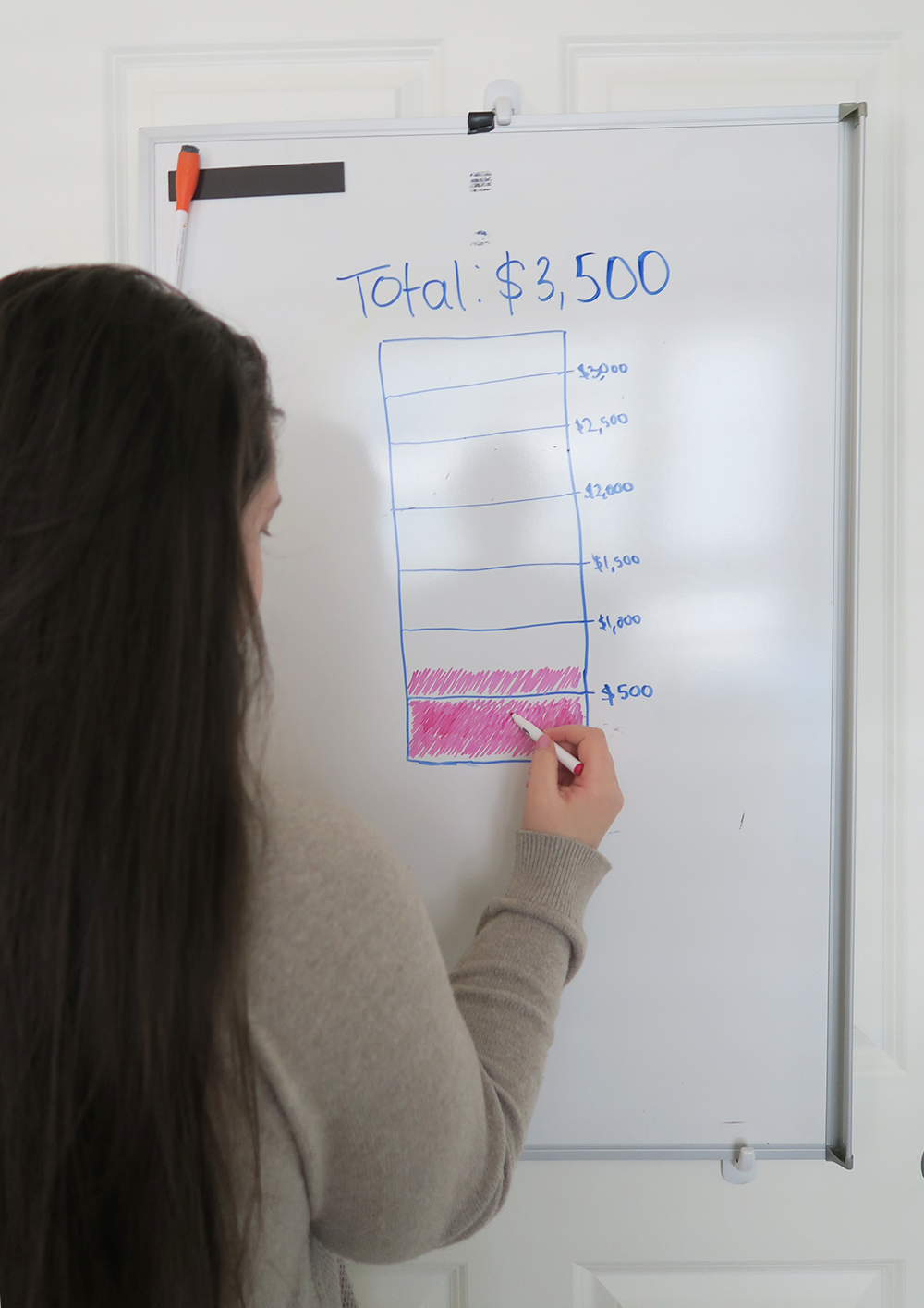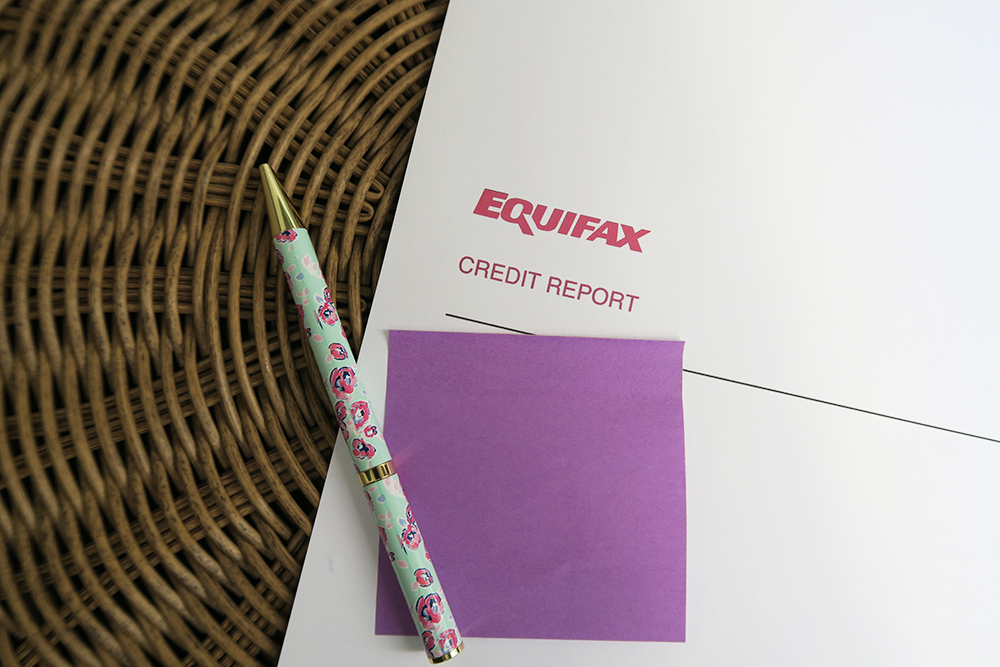This post is sponsored by Lexington Law.

If you’re reading this article, chances are you’re feeling a little bit defeated when it comes to your finances. You might feel like you’ve got a grasp on the basics but are struggling to put them into action and improve your financial confidence. I’ve been there.
For most people, paying off debt takes time. It’s not always as simple as cutting expenses or downsizing. It’s a struggle of reducing expenses as reasonably as possible while trying to increase your income and most likely juggling a full plate of other responsibilities.
I’ve discussed at length (here and here) how I paid off my debt in 18 months. Even for a dual-income household with no expenses other than rent and utilities each month, it felt like it took us a long time to make real progress on our debt.
Today, I want to share with you five ways to improve your financial confidence when you have debt. The average American household has $16,748 in consumer credit card debt, with around 80% of Americans having debt. If you want to be part of the 20% of those who don’t, it’s vital that you not only improve your financial knowledge, understand your emotional ties to money, and probably most importantly, believe that you can get out of debt and reach your financial goals.
Confidence grows and improves over time and it’s up to you to continually encourage that confidence to grow!
How To Be Financially Confident When You Have Debt
1. Set a savings goal under $1,000.
Saving $1,000 may or may not seem like a daunting task, depending on your financial situation. If you need some inspiration on how to make it happen, Jess discussed six ways to save money in a short period of time here.
For most of us, twenty-somethings especially, saving $1,000 in a short period of time — say three months — would be a challenge. You’d likely need to cut out some expenses and cut back on wants to meet your goal. It’s also possible you’ll have to find additional ways to earn money like a side hustle or selling unused items from your home.
Meeting goals improves our confidence. When we set out to do something, we are giving ourselves something to work towards with every decision we make. When you actually achieve said goal, not only do you have the reward of achieving it, but you have the satisfaction of knowing that you can. If you can achieve that goal, what is it that you can’t do?
If you think saving $1,000 dollars will be a challenge, start today. Once you’ve saved up that money, you can put it towards your emergency fund or but it towards a debt payment.
[clickToTweet tweet=”When we set out to do something, we are giving ourselves something to work towards with every decision we make. ” quote=”When we set out to do something, we are giving ourselves something to work towards with every decision we make. “]
2. Track your progress visually.
Sometimes paying off debt can feel like a long, uphill battle with no immediate reward. Sure, you know you’re improving your quality of life in the future. But when you’re making a lot of sacrifices now with nothing to show for it, it can be challenging to stay motivated.

Tracking your progress visually provides a type of instant gratification. Every time you make a payment, you can track it right in front of you! That instant reward can keep you motivated to make as many payments as possible.
Here are a few ideas for visually tracking:
- The Penny Jar: At the beginning of your paying-off-debt journey, fill up a jar with 1 penny for every $100 in debt you have. Whenever you make a payment, remove 1 penny for every $100 you pay off. It will be so satisfying to watch that jar empty over time! If you don’t want to use pennies, use jelly beans or wrapped candies! (That might be even better because you can eat them as you pay off your debt!)
- The Debt Thermometer: This is a very popular way of visually tracking debt pay-off. You’ll want to draw out a thermometer (or print one out from an online source). Start by putting the amount of money you owe at the top and zero at the bottom. In increments that make sense to you (it might be $100, $500, or $1,000 increments), make lines going up to the top. As you make your payments, fill in the space accordingly. You can do this for all of your individual accounts or for your cumulative debt, whichever makes the most sense to you.
- Graph It In Excel: If you’re not the artsy type, whip out an excel spreadsheet and get graphing! This will be simple, too, if you already track your budget in excel.
- Make a Paper Chain: Perhaps one of the most unconventional ways to track your debt payoff, but still fun nonetheless! Make a paper chain by cutting strips of paper and looping them within each other. Work towards zero by starting with a paper chain with one link per $100 you owe. Alternatively, work upwards by making one link for every $100 you owe. This could be a great way to get kids involved and teach them about money, too.

There’s nothing like a little visual motivation to keep you dedicated!
[clickToTweet tweet=”How To Be Financially Confident When You Have Debt ” quote=”How To Be Financially Confident When You Have Debt “]
3. Mind map out what financial confidence looks like in your everyday life.
By paying off your debt, you’re improving your financial life. You’re increasing your wealth and net worth, but you’re also giving yourself the power of financial freedom. When we are not held back by money, we’re able to make choices based on what we want to do rather than what we must do to survive.
Start by writing down what financial confidence looks like to you right now. This might mean:
- Treating your family to a nice dinner out without have to worry about the bill.
- Being able to cover a $2,000 emergency expense.
- Buying your favorite coffee every day.
- Living in your dream neighborhood.
- Leaving your full-time job to pursue entrepreneurship.
- Not scrimping the week before you get paid.
- Planning a vacation without having to save up for months or years.
- Knowing that your investments are growing while you’re having fun.

When I was paying off my debt, every time I made a payment, I dreamed how good it would feel to be able to put that money into savings instead of paying a loan provider. I wanted to be able to grocery shop without hunting for coupons each week. We wanted to try new restaurants on the weekends. I wanted to take day trips nearby and travel frequently to new countries.
Consider how your life will be five to ten years down the road when you feel savvy about money. How will your life be different if you’ve paid off your consumer debt? Will you feel differently when you’ve nearly paid off your mortgage? How will not having to worry about money free you up? How will you spend your time? Who will you spend it with? What will you do?

4. Focus on other aspects of your finances besides your debt.
If you aren’t able to pay off your debt in large chunks or very quickly, there are plenty of other financial aspects you can focus on:
-
- Check your credit score. When was the last time you checked your credit score? Around 47 percent of Americans are currently unaware of where they stand with this metric. In years past, it could be difficult to obtain this information, however, there are plenty of resources available at your disposal now. Here are five — at least one of these should work for you!
- Have your credit report evaluated. Did you know that an estimated 79 percent of credit reports contain errors? If it’s been years since you looked at your credit report (you’re entitled to a free one from each major bureau every year), it’s time to take a look! Negative items stay on your report for seven years, but there is no law that says they have to! If you’re struggling to understand your report or need help removing unfair negative items from your report, the team at Lexington Law is waiting to advocate on your behalf. They will challenge anything unfair, inaccurate or unsubstantiated item on your credit report, which will in turn, help increase your credit score. And remember, it’s key to work with someone who works for you and not a creditor or credit bureau.

- Improve your credit score. After having these errors removed and seeing where you stand, your next step should be working to improve your credit. This is a great thing to start doing, especially before you make any big purchases like a home or a car. There are a lot of myths and inaccurate information out there around credit scores, so we broke down four surprising things you might not know about your credit here. To figure out how to get started on improving your credit, Lexington Law has a fabulous guide on improving your credit!
- Call your service providers. Many times we’re overpaying for services simply because we didn’t try to negotiate or ask for a better price. I recently helped a friend save $200 (!!!) on her car insurance payment by shopping around for better options. Her current insurance provider wouldn’t match it, but making the switch was easy. And now she has 200 extra dollars per month. Make a list of all of the subscriptions you have. Think car insurance, renters or homeowners insurance, your internet, TV, or cell phone provider, to name a few. Do some research online to see what your other options are. See if your current providers will match the rate you found or discount your service. Generally speaking, it’s fiscally better for companies to give you a discount than to lose you as a customer. You can use this to your advantage as a customer!
5. Challenge yourself regularly.
As I mentioned before, confidence is strengthened over time. It’s really up to you to keep pushing and watch yourself succeed.
Doing so increases your stamina You’ll probably also found that your internal dialogue is becoming more positive as well. When you know you’ve met one goal, it becomes easier to hype yourself up and meet another and another.
Even though I paid off my student loan and consumer credit card debt several years ago now, I still like to challenge myself to stay sharp. If you once had debt, without managing yourself, it’s too easy to slip back into old habits and begin to justify extraneous purchases and loans. I’ve seen it happen to other people and I want to prevent that for myself.
Here are a few challenge ideas to inspire you:
- A No-Spend Challenge: Whether you want to try to go a week or a month without spending money on anything besides basic necessities, this is a great challenge to reset your mind! I completed a two month no-spend challenge in January and February of this year. After traveling and gifting over the holidays, I feel recentered when I take on the challenge.
- The 52 Week Savings Challenge: You can start this at any time, though many people enjoy starting at the beginning of the year. For week one, you deposit $1 into your savings account. Week two, you deposit $2. For week three, deposit $3, and so on until you reach the last week, number 52, when you’ll deposit $52 dollars into your savings account. If you follow through, you’ll have saved $1,387 at the end!
- Declutter Challenge: Take one month and go through your home to find 30 items that you are no longer using that you can resell. Put all of your earnings towards your debt payments!
- The Save 50% Challenge: Can you save 50% of your income in one month? This one is really hard to do, I can tell you from experience. You’ll have to be extremely mindful and budget conscious to succeed. Plus, you’ll likely have to put off any other *wants* purchases for future months. It does teach you discipline, though. You can go longer without things than you thought possible! (Tip: Try this in February, the shortest month of the year.)
Money is a truly emotional topic and it can be really difficult to find your confidence financially. Especially when you’re burdened with debt repayment.
By setting an achievable savings goals and challenging yourself regularly, you’re proving to yourself that you can reach the financial goals you set. This alone is a major confidence builder! Tracking your progress visually gives you a physical manifestation of something that can otherwise feel invisible. With every payment you make, you’re getting yourself closer to financial freedom.
When you’re focusing on other aspects of your finances besides debt, you’re setting yourself up for powerful financial future. Lexington Law’s financial experts there to answer your questions, advocate for you, and help you build your strongest financial future possible. You can feel confident knowing that they are in your corner. Mind mapping financial freedom means to you and giving yourself the resources to achieve it are undeniably powerful ways to build a financial foundation when you have debt.
Having debt is not the end of the world. But paying of that debt? Well, that can lead to a life you’ve always dreamed of. We believe it’s fully within your control to find your financial confidence — it’s up to you to build it!

